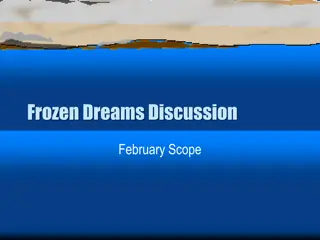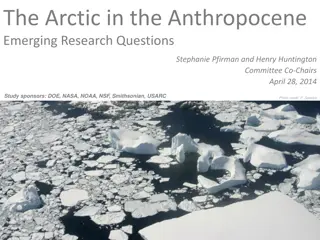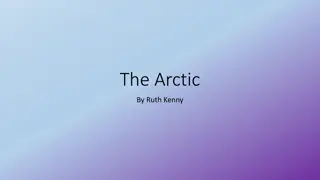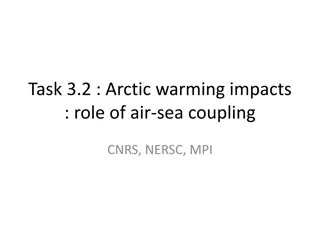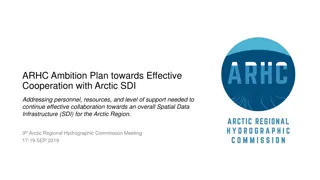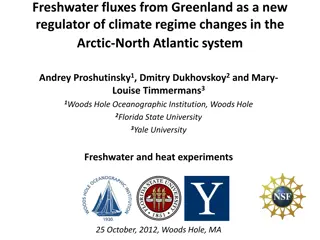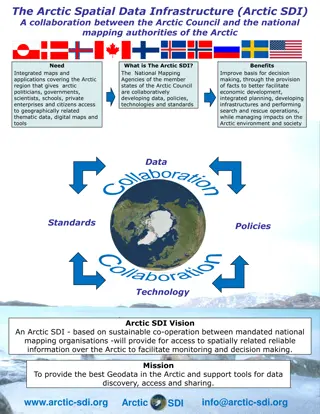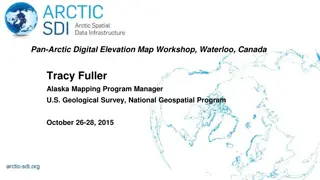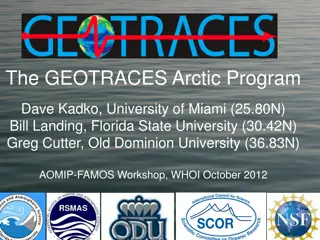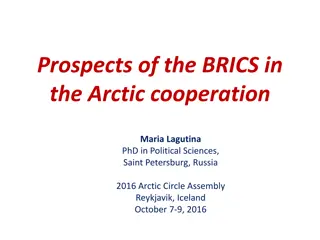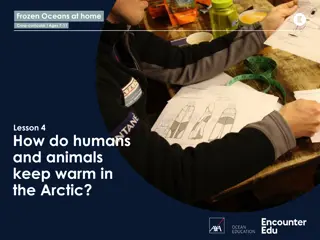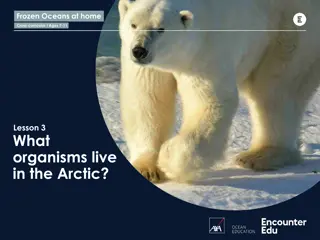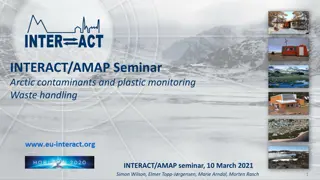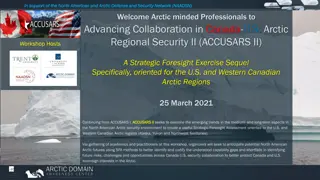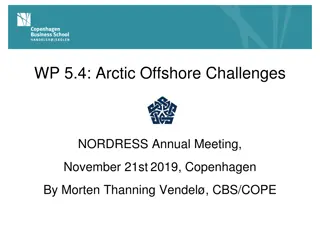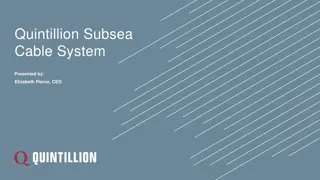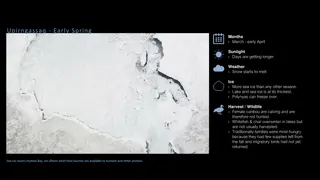Progress Summary of ARCTIC WP6 Activities
Continuing the development of the OBPS Arctic Community, WP6 has achieved significant milestones including document organization, peer-reviewed paper submissions, workshop endorsements, and engagement with Arctic Working Groups. Efforts are aimed at advancing Indigenous approaches to ocean observing, fostering collaboration with Russian partners, and supporting CAPARDUS WP4 initiatives. Various surveys and discussions reflect the diverse focus areas within the Arctic community.
Download Presentation

Please find below an Image/Link to download the presentation.
The content on the website is provided AS IS for your information and personal use only. It may not be sold, licensed, or shared on other websites without obtaining consent from the author.If you encounter any issues during the download, it is possible that the publisher has removed the file from their server.
You are allowed to download the files provided on this website for personal or commercial use, subject to the condition that they are used lawfully. All files are the property of their respective owners.
The content on the website is provided AS IS for your information and personal use only. It may not be sold, licensed, or shared on other websites without obtaining consent from the author.
E N D
Presentation Transcript
CARADUS WP6 Wednesday, January 13, 2022 Powered by
Summary of WP6 Continue developing the OBPS Arctic Community (Pauline Simpson) 84 documents in Community as of Jan 13 2022; 357 documents from search on Arctic Working on accepting non-English documents Endorsement OBPS Workshop with Arctic Session in September 2021 Peer Review Paper submitted to Marine Policy Journal: Two Eyes on the Sea: Opportunities for advancement of Indigenous approaches to ocean observing in the context of ocean sustainability January 2022 (Jay and Pier Luigi) Created Survey for APS requirements (SJSK, Noor, Pauline) Engaging selected Arctic WGs in discussions observations, data, Supporting CAPARDUS WP4 engagement with Russian partners Supported survey formation for Svalbard Powered by
Arctic Practices System Requirements Survey Wednesday, January 12, 2022 Powered by
21 on Wednesday Jan 12 (32 on Jan 14) Total Responses Date Created: Tuesday, December 21, 2021 Complete Responses: 21 included in the following results up to Jan 12 Powered by
Q5: What type of organization are you in? (Check one or more) Answered: 21 Skipped: 0 Powered by
Q5: What type of organization are you in? (Check one or more) Answered: 21 Skipped: 0 Powered by
Q6: What do you focus on in your Arctic work? (indicate one or more topics that you are active in; choose 1 for the one where you put the most effort)? Answered: 21 Skipped: 0 Powered by
Q7: What are your priorities for APS characteristics Answered: 18 Skipped: 3 Powered by
Q8: What type of access to APS should be included in the user interface? (you may chose more than one) Answered: 18 Skipped: 3 Powered by
Q10: How important is capacity development as part of the APS services/design? Answered: 19 Skipped: 2 Capacity development here applies to knowledge of how to document practices and how to use the APS effectively. Powered by
Q13: Would you be interested in participating in the APS requirements discussions? Answered: 17 Skipped: 4 Powered by
Q14: For your work, do you create ways of doing things (which may become recognized as Arctic practices)? Answered: 18 Skipped: 3 Powered by
Q15: in what format do you record your practices or maintain knowledge of a practice? Answered: 18 Skipped: 3 you may choose more than one, please prioritize the ones selected with number one being the highest priority) Powered by
Q20: Have you adopted any formally-recognized (we call these "de jure") standards in your work (such as ISO standards)? Answered: 18 Skipped: 3 Powered by
Q21: How often do you use formally-recognized standards in your work (such as ISO standards)? Answered: 17 Skipped: 4 Powered by
Additional steps Wednesday, January 12, 2022 Powered by
Guidelines for Format of White Papers 5000 words or less (~10 pages of text) and references as appropriate; List all coauthors, affiliation(s), institutions and contact information; Identify a main contact; The title should be descriptive; Include an abstract (300 words maximum); Up to three 3 figures. Powered by
Guidelines for White Paper Reviewers Guidelines for White Paper Reviewers Reviewers will assess how well the white papers address the overarching goals and expected outcomes of the AOS (e.g. under the AOS themes, does the white paper contribute to recommendations, highlight an issue or opportunity, suggest a solution or strategy, introduce an initiative or describe ongoing work related to AOS, mention work for future Summits, etc.). Reviewers are not asked to provide acceptance/rejection-type evaluations or full technical reviews of the underlying science. Reviewers should suggest revisions where appropriate and feasible within the given time frame. Focus on providing constructive feedback and improving alignment with AOS objectives. Reviews should include general comments and suggestions for how authors can tie their papers into the set of topics and themes to be discussed at the Summit. Consider in the comments how the white papers can contribute the discussions in the break-out groups, as well as recommendations emerging from the Summit. Reviews should include comments that provide concrete alignment with AOS themes, possible Powered by recommendations, and proposed solutions.
ROADS ( Roadmap for Arctic Observing and Data Systems) EAVs shall be specified by their observing system (e.g. spatial resolution, frequency, latency, uncertainty) and data management requirements, which should transcend specific observing strategies (i.e. technology neutral), programs or regions. They shall be implemented through specific recommendations based on Arctic-viable technology and practices. EOVs have related best practices for their implementation. EAVs are likely to follow this model. APS can be a foundation element in POADS process implementation Powered by
Literature Ocean Obs 19 Lee et al A framework provides a systems-level view of observing requirements, best practices and data delivery plans toward applications for which the observing system is intended. Requirements and best practices for system design, including platforms and instrumentation, data processing, quality control and long term preservation, Recommendation 4. To maximize the uptake of observations and derived products, all data must be secured in long-term storage in an established data repository adhering to best practices for scientific data management. Powered by
Next Steps Understand the role of practices in the Arctic and define how the APS can support this role Tools include surveys, interviews, panels Creating guidelines and engage the diverse Arctic stakeholders. Powered by










